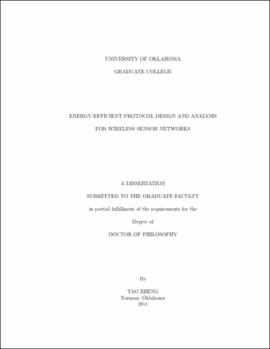| dc.contributor.advisor | Radhakrishnan, Sridhar | |
| dc.creator | ZHENG, TAO | |
| dc.date.accessioned | 2019-04-27T21:33:44Z | |
| dc.date.available | 2019-04-27T21:33:44Z | |
| dc.date.issued | 2011 | |
| dc.identifier | 99302110502042 | |
| dc.identifier.uri | https://hdl.handle.net/11244/319011 | |
| dc.description.abstract | Wireless sensor networks are an emerging technology which has the promise of revolutionizing the way of collecting, processing and disseminating information. Due to the small sizes of sensor nodes, resources like battery capacity, memory and processing power are very limited. Wireless sensor networks are usually unattended once | |
| dc.description.abstract | deployed and it is infeasible to replace batteries. Designing energy-efficient protocols to prolong the network life without compromising too much on the network performance is one of the major challenges being faced by researchers. | |
| dc.description.abstract | Data generation in wireless sensor networks could be bursty as it is dictated by the presence or absence of events of interest that generate these data. Therefore sensor nodes stay idle for most of the time. However, idle listening consumes as much energy as receiving. To save the unnecessary energy consumption due to idle | |
| dc.description.abstract | listening, sensor nodes are usually put into sleep. | |
| dc.description.abstract | MAC protocols coordinate data communications among neighboring nodes. We designed an energy-efficient MAC protocol called PMAC in which sleep-awake schedules are determined through pattern exchange. PMAC also adapts to different traffic conditions. | |
| dc.description.abstract | To handle bursty traffic and meanwhile preserve energy, dual radio interfaces with different ranges, capacity and power consumption can be employed on each individual sensor node. We designed a distributed routing-layer switch agent which intelligently directs traffic between the dual radios. The low-power radio will be used for light traffic load to preserve energy. The high-power radio is turned on only when the traffic load becomes heavy or the end-to-end delay exceeds a certain threshold. Each radio has its own routing agent so that a better path can be found when the high-power radio is in use. | |
| dc.description.abstract | Data gathering is a typical operation in wireless sensor networks where data flow through a data gathering tree towards a sink node. DMAC is a popular energyefficient MAC protocol specifically designed for data gathering in wireless sensor networks. It employs staggered sleep-awake schedules to enable continuous data forwarding along a data gathering tree, resulting in reduced end-to-end delays and energy consumption. we have analyzed end-to-end delay and energy consumption with respect to the source node for both constant bit rate traffic and stochastic traffic following a Poisson process. The stochastic traffic scenario is modeled as a discrete time Markov chain and expressions for state transition probabilities, the average delay and average energy consumption are developed and are evaluated numerically. Simulations are carried out with various parameters and the results are in line with the analytical results. | |
| dc.description.abstract | Lots of work had been done on constructing energy-efficient data gathering trees at the routing layer. We proposed a sleep scheme at the routing layer called DGSS which could be incorporated into different data gathering tree formation algorithms. Unlike DMAC, in which nodes are scanned level by level, DGSS starts scanning | |
| dc.description.abstract | from the leaf nodes and shrinks inward towards the sink node. Simulation shows that DGSS can achieve better energy efficiency than DMAC at relatively higher data rates. | |
| dc.format.extent | 163 pages | |
| dc.format.medium | application.pdf | |
| dc.language | en_US | |
| dc.relation.requires | Adobe Acrobat Reader | |
| dc.subject | Sensor networks--Design and construction | |
| dc.subject | Wireless LANs--Design and construction | |
| dc.subject | Computer network protocols | |
| dc.title | ENERGY-EFFICIENT PROTOCOL DESIGN AND ANALYSIS FOR WIRELESS SENSOR NETWORKS | |
| dc.type | text | |
| dc.type | document | |
| dc.thesis.degree | Ph.D. | |
| ou.group | College of Engineering::School of Computer Science | |
